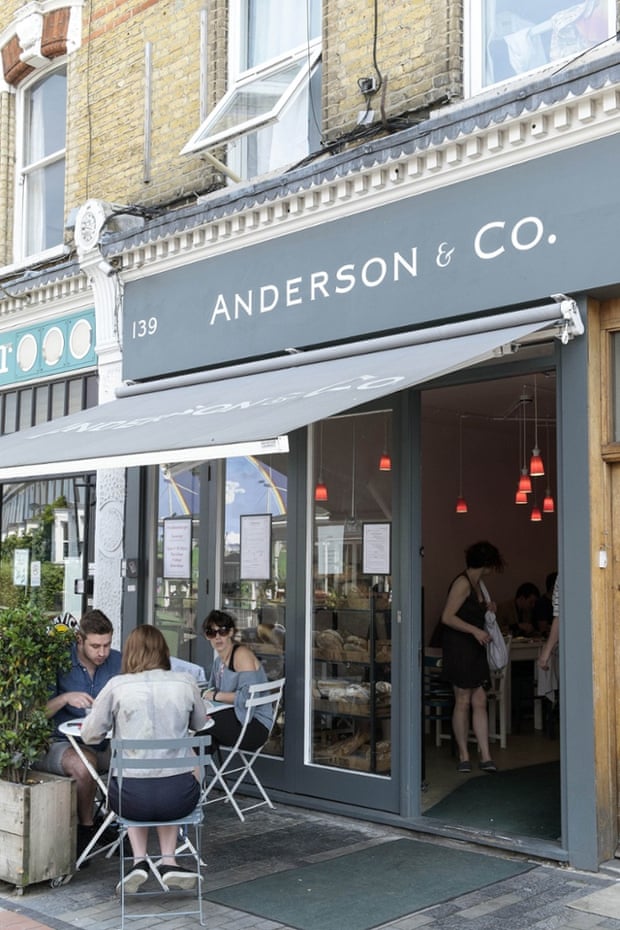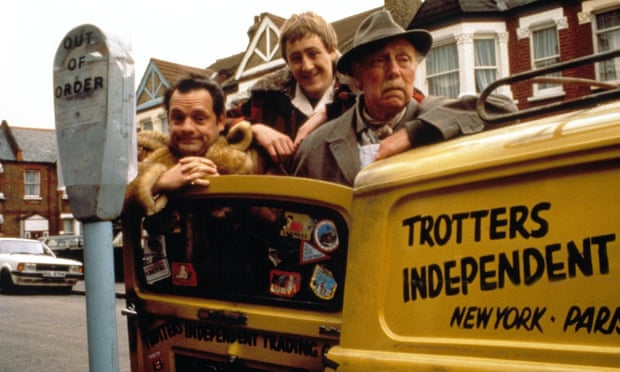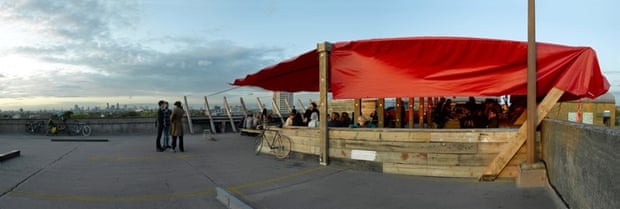
Del Boy hardly ever took his Reliant three-wheeler to the mean streets of SE15, as most of the BBC sitcom was shot outside London. But he’d be shocked at the la-di-dah Peckham of today ... and impressed by its entrepreneurial spirit
|
Del Boy hardly ever took his Reliant three-wheeler to the mean streets of SE15, as most of the BBC sitcom was shot outside London. But he’d be shocked at the la-di-dah Peckham of today ... and impressed by its entrepreneurial spirit

If Only Fools and Horses is a reliable guide, and it probably isn’t, Peckham has long been a dodgy manor teeming with shifty herberts temperamentally ill-suited to following the straight and narrow. Boycie, Del Boy Trotter’s rival as Peckham’s leading entrepreneur in the BBC sitcom, once explained where the south-east London district, historically, went wrong. “Did you know, 500 years ago this was a green and peaceful area?” asked Boycie (AKA Terrance Aubrey Boyce). “The old Earl of Peckham had a castle where the Kwik-Fit exhaust centre now stands. Flaxen-haired maidens used to dance round the village maypole of an evening. And then one fateful medieval day, the Trotter clan arrived in a stolen Zephyr. Before you knew it, the flaxen-haired maiden was up the spout, the old Earl had been sold some hooky armour and someone nicked the maypole.”
But John Sullivan’s beloved sitcom, which ran from 1981 to 1991 with Christmas special episodes is, as a guide to Peckham, as unreliable as the bottles of Peckham Spring (really tap water) Del sold in the 1992 Christmas special. In part, that’s because the sitcom wasn’t filmed in Peckham. Instead, locations in Brighton, Salisbury, Ipswich, Hull, Bristol, west London and other English towns and cities were used. In truth, Del Boy hardly ever took his Reliant three-wheeler south of the river, still less down SE15’s mean streets.
What’s more, Only Fools and Horses made Peckham seem overwhelmingly white and British. Even a few years ago this was laughably wide of the mark. According to the 2001 census 35.67% of Peckham was black African, 15.45% black Caribbean and 25.73% white British. In 2015, it’s one of the most ethnically diverse districts of an already diverse city, with communities whose ancestors came from Bangladesh, the Caribbean, China, India, Ireland, Nigeria, Pakistan, Turkey, eastern Europe and Vietnam.
And in 2015, surely Peckham is less like the way it was depicted in Only Fools and Horses than ever. Not only is it more ethnically diverse than ever, but Peckham has gone, intolerably, la-di-dah. At least Del Boy’s mum might have liked it: “My mum was a lady. Do you know, she was the first woman in Peckham to smoke menthol cigarettes?”
Arguably it was the Stirling prize-winning, part-EU-regeneration-money-bankrolled Will Alsop-designed library that started the rot in 2000, making SE15 a destination for po-mo architecture-loving fops and their ancillary industries. Before you could say “You plonkers!”, it was pop-up this, pastry shop that, organic how’s your father and lots of other developments that, you’d think, would make Del cry into his sheepskin collar.
To be fair, one can imagine him urging the mixologists to make his favourite cocktail – the Caribbean Stallion – at Frank’s, the summertime cafe and bar on the 10th floor of Rye Lane’s multi-storey car park, before savouring the view towards Battersea Power Station. But he would surely roll his eyes at Peckham’s recent property boom and all those articles setting out why SE15 is the best place to live in London. Recently, a scruffy, formerly squatted house went on sale for £650,000.

How come? “Peckham has become attractive to creative people with money because of its good transport links,” says urban ethnographer and assistant at the LSE Suzanne Hall. “You can be in the East End in 12 minutes and that, plus the proximity of Goldsmith’s [College] and Camberwell College of Art, has attracted creative types, some of whom have money,” says Hall. “But it’s really only the terraced houses that are commanding big sums. That’s where the focus of the global appetite for investing in London is in Peckham. There is still lots of social housing estates where it’s a very different story. There remains a great deal of deprivation.” Southwark, the London borough of which Peckham is a part, is one of London’s poorest, she says.
Happily, there is more to Peckham than the typical London story of deprivation sitting cheek-by jowl with real-estate bankrolled wealth. “There are plenty of Del Boys around Peckham now,” says Hall. “It’s just that they’re more likely to be Albanian or Nigerian than white working-class English people. There’s plenty of the ducking and diving and informal entrepreneurialism going on.”
Hall co-ordinated a three-year ethnographic study called Ordinary Streets, part of which focused on small independent shops in Rye Lane appropriated by successive waves of immigrants. “One thing we wanted to do was to try to map skills and entrepreneurialism, not just deprivation, which is too often the focus,” she says. Hall’s point is that today’s Del Boys have skills that go unrecognised by local council bureaucrats when they embark on regeneration plans. “The council has been unsympathetic to migrant activity on Rye Lane, preferring to go for more conventional ideas of regeneration, which means more chains rather than small independent stores where the really business acumen is.” Indeed, Hall reckons that the super-diverse shopping street of Rye Lane, with its bargain stores and ethnic food shops, has more retail outlets per square metre, is more profitable and thus pays more rates than the glitzy shopping centre of Westfield Stratford. Del Boy Trotter, you’d think, would be proud of what Peckham has become.
All the above may well explain why there are no Only Fools and Horses tours of Peckham. Undaunted, I cobbled together an impromptu tour of some of the sitcom’s London locations to see what has changed since the show went off air. Ideally, I would have toured in a Reliant Regal van, but such transport proved impossible to hire for the day.
Nelson Mandela House, the tower block where the Trotter family lived, doesn’t exist. Instead, the location used in Only Fools and Horses for the first few series was Harlech Tower, Park Road East, Acton, in west London. For years Harlech Tower has been under threat of demolition as part of Ealing council’s regeneration plans for the sprawling South Acton Estate (west London’s answer to the notorious North Peckham Estate), but there it is still standing when I drive up. Four years ago, one of the flats in this tower was fitted to look like Del’s flat in Nelson Mandela House – with horrible carpet, blow-up sex doll, old television, tacky bar and some terrible furniture – and rented out at 1981 prices, £18 per night, to commemorate the 30th anniversary of the start of Only Fools and Horses.
But a lot has changed since 1981. A year earlier, Margaret Thatcher introduced the right to buy council homes. If Del Boy had bought the Harlech Tower flat in which filming took place, he would have made a tidy profit – recently a two-bed flat in the block went on sale for £265,000. But he might have done better had he exercised his right to buy in Peckham: estate agents estimate that a three-bedroom flat in SE15 of the kind we see the Trotters living in during the show would now fetch £330,000. Lovely jubbly!
Who can forget The Jolly Boys’ Outing, the 1989 Christmas special when Del, Rodney and their mates went on a coach trip to Margate? And the club where Del and co have scampi before seeing a magic act called The Great Raymondo and Raquel? Let’s not forget, either, the scene in which Del, suspecting Raymondo of blackmailing Raquel sexually in return for a job and accommodation, punches the magician, only to find out later that Raymondo is gay? Well, the Mardi Gras Night Club scenes were filmed at the Top Hat club in Ealing, west London. Nowadays the Top Hat is Ealing Christian Centre (266 Northfield Avenue, W5 4UB), which houses the Elim Pentecostal Church. The 1,200-seater converted former cinema offers Holy Spirit evenings, bible study classes and services in English, Japanese and Polish. But there’s no easy way to say this: they don’t serve scampi. And the Great Raymondo? He isn’t on the bill any more.
There is a pub of the same name in Rye Lane, Peckham. But this blamelessly ungastropubified joint (very different from, say, more genteel SE15 establishments such as The Rye, with its sunken terrace and outdoor table tennis tables) was, sadly, never used as a location in the series. Instead, a vast range of boozers stood in for the Trotters’ favourite watering hole, some of them in Bristol and at least one demolished. But not all. The London pubs used as locations for the Nag’s Head include the Middlesex Arms (Long Drive, South Ruislip, HA4 0HG) and the Bolton Hotel (Duke Road, Chiswick). In 2015, neither is the kind of place the Trotters would have patronised: the former serves mocktails, whatever they are, and the latter stopped being a pub in 1995 and was converted for residential use – the unacceptable fate of many the British boozer in the post-Only Fools and Horses age.
Remember when Del, Rodney and Albert were mistakenly apprehended as shoplifters by an overzealous security guard at the Top Buy Supermarket in the 1986 episode The Longest Night, with Del and Rodney held up overnight by an armed robber who wants to break into the time-coded safe when it opens at 8am the following morning? Well, that episode was filmed at the supermarket in 829-837 Leytonstone High Road, east London E11 1HH. Today it’s a Matalan. When I visited, the security staff didn’t seem overzealous, nor were fellow shoppers obviously armed, and the retailing experience was generally less stressful than when the Trotters visited. That said, I wouldn’t want to spend the night there in the manager’s office with a trigger-happy robber.
In the final scene of the last episode, Sleepless in Peckham, screened in 2003, Del and Rodney drive off along the West Cross Route in Shepherd’s Bush, west London (post code W12 7SL) back home to Nelson Mandela House after visiting the grave of their mother. Like many of the west London locations used in the sitcom, the West Cross Route seemed more convenient for BBC TV centre in White City than for access to the glories of Peckham. Today the dual carriageway is as glumly functional as ever it was, but there have been some other changes that would surprise Del and Rodney. The nearby BBC TV Centre is derelict, and yet another temple to consumerism, London’s other Westfield shopping centre, now dominates the cityscape. Underneath the shopping centre there is ample parking, but, sadly, not one Reliant Regal. Del and Rodney would hardly recognise the place. Things have changed in London since they went on that last bittersweet drive back to Peckham, but not always for the better.
If you live in Peckham, how does the area differ from its cultural depiction – and how has it changed? Share your thoughts in the comments below